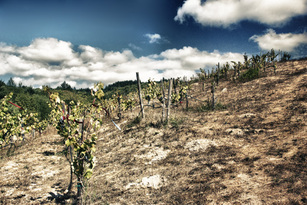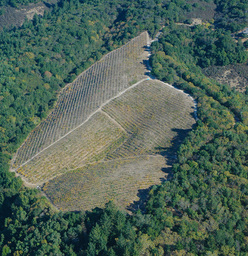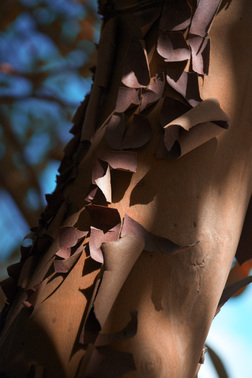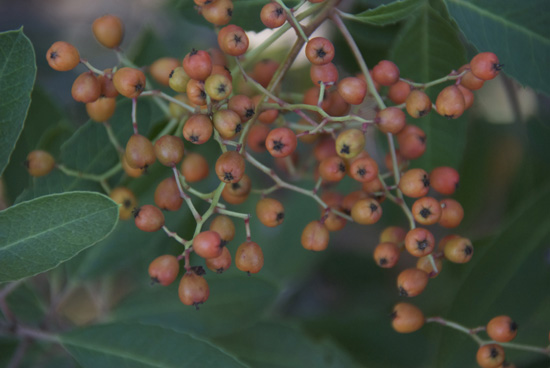Cooke Vineyard - Sonoma
Cooke Vineyard is 10 acres of Zinfandel planted on a steep hillside about 1200 feet above the Sonoma Valley floor at the lower end of the Mayacamas Range. The ground is an outcrop of rhyolite flows and volcanic ash. A jumble of rocks dot the landscape, sticking out between the struggling vines while tuffs of wild grass and thistle carpet the solid surface. The vineyard cascades down at a sharp angle with the vines at the top of the hill looking much older than their peers. Those at the bottom of the hillside are lush and full, spoiled by the extra attention the runoff from the steep landscape affords them, but they are the rare ones and most of the vines struggle with their place on the hillside. With a southwestern exposure, sunshine is in abundance, and a cool breeze that blows through each day helps temper the vines creating fruit that is balanced and flavorful.
Charlie Cooke was born into a career military family in 1931. His father, Charles M. “Saavy” Cooke was a four-star Admiral, and the life and lessons of growing up in the Navy were a strong influence on Charlie. He went to the Naval Academy, was commissioned in the U.S. Air Force and later attended the University of Washington where he earned a master’s degree in Chinese history and language. He then developed a Chinese language studies course at the Air Force Academy in Colorado and taught classes on Communist warfare. In 1967 Charlie went to Saigon to work on the first joint pacification plan for Vietnam. When he returned state side he joined the Defense Department, contributing to the Pentagon Papers and later worked for the State Department as a Special Advisor on Vietnam.
He was influenced by his father’s career and the places they lived, but it was his mother’s encounter with a famous writer that landed them in Sonoma. Before she married Charlie’s father, Mary Louise Cooper was living in Hawaii and working as a newspaper reporter when she met Jack London and his wife Charmian. A lifelong friendship developed between them and it was the stories Charmian told of the London’s beloved home in Glen Ellen that eventually lured the Cooke’s to Northern California. Many years later, when Louise and Saavy were making retirement plans, they decided on buying property in the San Francisco area. During a visit with Charmian at Beauty Ranch, Louise learned there was a 193 acre ranch in across the valley in Sonoma that was being sold. In 1937 they bought the ranch and for Charlie, it was the place he would always call home
He was influenced by his father’s career and the places they lived, but it was his mother’s encounter with a famous writer that landed them in Sonoma. Before she married Charlie’s father, Mary Louise Cooper was living in Hawaii and working as a newspaper reporter when she met Jack London and his wife Charmian. A lifelong friendship developed between them and it was the stories Charmian told of the London’s beloved home in Glen Ellen that eventually lured the Cooke’s to Northern California. Many years later, when Louise and Saavy were making retirement plans, they decided on buying property in the San Francisco area. During a visit with Charmian at Beauty Ranch, Louise learned there was a 193 acre ranch in across the valley in Sonoma that was being sold. In 1937 they bought the ranch and for Charlie, it was the place he would always call home
|
Charlie had thought a lot about the idea of a vineyard, remembering his parents telling him that one had existed on the property before they bought it. Then there was an old aerial photograph that Charlie discovered of the ranch showing remnants of a vineyard that due to Prohibition, had long been abandoned, and by 1979 not even a shadow of it remained. Charlie, and his wife Sara Peterson sought the advice of Joe Miami, a well regarded viticulturist and one of the few growers who had extensive experience in hillside planting and farming. At the time Joe was the head of vineyards for Martini but happy to share what he knew. Sara recalls Joe coming to the ranch, walking with them in the woods on the hillside above the house and discussing the possibilities of a vineyard. With the help of the photograph and landmarks, they determined the general vicinity of the old vineyard - it was near there that Charlie and Sara decided to plant the new vineyard.
|
|
The hillside was heavily wooded with scrub and oak and the site they selected required a great deal of labor to clear. Poison oak was everywhere and caused one of the tractor drivers to be hospitalized from an allergic reaction. The site was never very welcoming to the idea of a vineyard and Charlie used dynamite to blow holes in the ground to offer his vines a head start in the unforgiving rock. One can only image the determination and backbreaking work needed to establish the original vineyard if dynamite was now the key to that hard rock’s heart. Joe made his recommendations and Phil Couturri, a respected viticulturist even then, along with Barney Fernandez who managed the old Glen Ellen vineyards, began planting in 1979.
AxR1 "Aramon Rupestris Ganzin No. 1" was selected for the rootstock with the zinfandel budwood coming from the Glen Ellen vineyard by way of Barney. Vigorous and easy to graft, AxR1 was the rootstock of the day and highly touted by UC Davis. Yet as time was to reveal, AxR1 had serious flaws. Many vines planted to AxR1 succumbed to phylloxera, a soil louse that feeds on the root system of the vine decimating the roots ability to uptake water and nutrients. Eventually the plant dies. The Cooke vineyard did not require extensive replanting as many others had to do, but any vines that are interplanted or need replacing are on St. George rootstock. |
|
The root system of a vine grows down and out, with most of the root system generally in the top two feet of soil. Vine roots have less density but tend to go deeper than most plants, foraging for nutrients and water in meager soils. Some of the root systems of Charlie’s vines didn’t know which way to go. Discouraged by the resistance they faced in the hard rock, they grew upward instead of down, seeking out whatever nourishment they could find. The vines certainly struggled as they tried to establish themselves, but Charlie believed the site would produce high quality fruit, albeit not much of it, and now with the vines well into their early 30s the vineyard produces less than one half ton per acre. Charlie was right about the fruit – it is intense and the wine produced, long lived.
|
The vineyard is surrounded by oaks and at its crest, California bay laurel, manzanita and Pacific madrones. Inside the vineyard, along the deer fence, a few old oaks that found their footing long ago offer some shade. A small round table and a few haggard plastic chairs are evidence of the work camp the vineyard crew set up underneath one of those oaks. There they find respite from the heat, enjoy the cooling breeze and take in the view from Charlie’s hill – a beautiful sweep over Sonoma Valley and on a clear day, the San Francisco skyline shimmering in the distance.
Arbutus menziesii, commonly known as the Pacific madrone, is a native of the region and easily recognized by it's deep red hue, peeling bark, white flowers and bright orange berries. It is extremely drought tolerant and often found in mixed stands of California black oak, Douglas-fir and bay laurel. The berries are an important food source for birds and mammals.
|
Vineyard Owner: Sara Peterson
Vineyard Manager: Tom Gore Grape Variety: Zinfandel Rootstock: AxR1 and St. George Elevation: 1200 feet Soil: rhyolite flows and volcanic ash Fruit sourced by: Ravenswood |
Charlie was a no-nonsense kind of man and while he may have rattled a few folks' sensibility, he got things done. He was a force in the development of the Agricultural Preservation and Open Space District in Sonoma and thanks to him, huge tracts of Sonoma land are preserved in perpetuity against development, including his beloved ranch.
A spirited man with a wiry sense of humor and a fierce intellect, he loved growing camellias and sharing the persimmon pudding he made from the numerous trees that grew around his home on the ranch. He delighted in story telling, having many a story to tell and enjoyed walking the vineyard with his Golden retriever Zinfandel. He lived a rich life full of adventure and friendships. For many, the impact of his life and influence he had on others, like the wine from his vineyard, will be long lived. Story content provided by: Lisa Supple and Sara Peterson |








